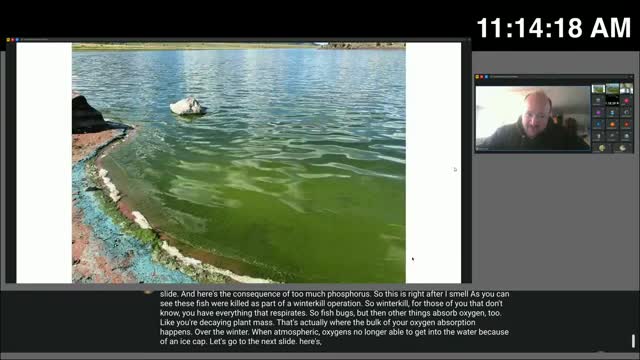Solar B technology reduces harmful algae blooms at Calder Lake
March 22, 2025 | Natural Resources Department, Utah Environment, State Agencies, Organizations, Utah Executive Branch, Utah
This article was created by AI summarizing key points discussed. AI makes mistakes, so for full details and context, please refer to the video of the full meeting. Please report any errors so we can fix them. Report an error »

The Blue Ribbon/Habitat Council Joint Meeting held on March 20, 2025, focused on addressing the issue of harmful algal blooms (HABs) in Utah's water bodies, particularly the Matt Warner Reservoir. The meeting highlighted the detrimental effects of blue-green algae on aquatic life and the ongoing efforts to mitigate these impacts.
One of the key solutions discussed was the implementation of a solar-powered device known as the "solar b," which was installed at Calder Lake in 2022. This technology promotes water circulation year-round, helping to manage nutrient levels and prevent conditions that lead to winter fish kills. The device has shown promising results, maintaining open water areas even during colder months, which is crucial for sustaining fish populations.
Data presented during the meeting illustrated the effectiveness of the solar b in maintaining dissolved oxygen levels in Calder Lake compared to Kraus Lake, which lacks such technology. The graphs indicated a concerning decline in oxygen levels in Kraus Lake, raising alarms about potential fish mortality. The meeting underscored the importance of monitoring these conditions, as low oxygen levels can severely impact fish feeding and survival.
The discussions emphasized the need for continued investment in innovative solutions like the solar b to protect Utah's aquatic ecosystems. The council aims to replicate the success seen at Calder Lake in other reservoirs, including Matt Warner, to combat the challenges posed by harmful algal blooms and ensure the health of local fisheries. The meeting concluded with a commitment to further research and collaboration in addressing these environmental concerns.
One of the key solutions discussed was the implementation of a solar-powered device known as the "solar b," which was installed at Calder Lake in 2022. This technology promotes water circulation year-round, helping to manage nutrient levels and prevent conditions that lead to winter fish kills. The device has shown promising results, maintaining open water areas even during colder months, which is crucial for sustaining fish populations.
Data presented during the meeting illustrated the effectiveness of the solar b in maintaining dissolved oxygen levels in Calder Lake compared to Kraus Lake, which lacks such technology. The graphs indicated a concerning decline in oxygen levels in Kraus Lake, raising alarms about potential fish mortality. The meeting underscored the importance of monitoring these conditions, as low oxygen levels can severely impact fish feeding and survival.
The discussions emphasized the need for continued investment in innovative solutions like the solar b to protect Utah's aquatic ecosystems. The council aims to replicate the success seen at Calder Lake in other reservoirs, including Matt Warner, to combat the challenges posed by harmful algal blooms and ensure the health of local fisheries. The meeting concluded with a commitment to further research and collaboration in addressing these environmental concerns.
View full meeting
This article is based on a recent meeting—watch the full video and explore the complete transcript for deeper insights into the discussion.
View full meeting

